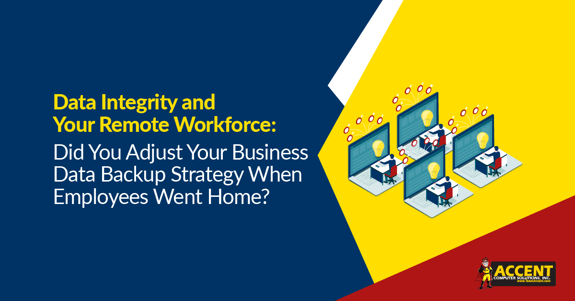You may not always think of it this way, but your business information is a valuable asset. Without your data, business operations would come to a screeching halt or at least a slow crawl. Like any other asset, your business data needs to be protected.
Unfortunately, many companies unknowingly compromised the integrity of their data when they sent people home to work. What’s more, they don’t realize how spreading out their people to their individual remote locations may have affected their data backup strategy.
What is Data Integrity?
Integrity refers to the quality and reliability of your data. In simple terms, we can define data integrity with three characteristics.
- Accuracy – data is correct and up to date.
- Completeness – data does not have any gaps.
- Availability – data is there when you need it.
Concerns about data integrity are obvious. You want your business transactions to be accurate and you want to make good business decisions. Lack of data integrity causes mistakes that can be costly, threatening customer and employee satisfaction by creating a climate of confusion.
Unfortunately, some data integrity challenges won’t show up until you need to use your data backup to get up and running after an event, such as a power outage, natural disaster, or even a water pipe leak in your building.
Before we talk about the connection between data integrity and data backup, let’s explore how your remote workforce can be compromising data integrity, and take a look at the behaviors that are at the root of the problem.
Remote Workers and Out-of-Sight Data
In a previous article, we explained how your remote workers could be taking your business data outside of your company’s secure perimeter. Because you had to move fast to get everyone set up to work from home, your priority may have been to get everyone functional, and maintaining data integrity was inadvertently neglected.
If you answer “no” to any of these scenarios, then it’s very possible that your data integrity has been compromised.
- Did you supply every remote worker with a company-managed computer?
- Did you make sure that employees had sufficient and consistent access to your server?
- Did you supply employees with collaboration tools so that they didn’t need to email documents back and forth or find some other workaround?
- Did you provide employees with Remote Work Security Policies and train them how to follow them?
You might have to ask around to get the answers to these questions. Like you, your employees were concerned with how they were going to continue business operations. They might not realize that doing something like saving files to their own computer when they couldn’t get to the server was creating out-of-sight data when they were just trying to do their jobs.
The Connection Between Data Integrity and Data Backup
Much of the usefulness of your data backup has to do with its accuracy, completeness, and availability. (Sound familiar?)
If your remote setup has created out-of-sight data, then you have a gap in all three areas of your backup. That makes your data backup less effective at recreating the trail of transactions that lead up to your recovery point.
Why You Need to Adjust Your Business Data Backup Strategy
The day that you set up your remote workforce was the day that you became a multi-location business.
The backup strategy that utilized equipment onsite at your office and your internal network had to suddenly be accessed from outside of your network and, because of factors like internet bandwidth, it might not work as well as you need it to. Additionally, if employee behaviors started taking data to places where IT can’t see or manage it, then it’s not being backed up at all.
If your backup strategy doesn’t fit how your business runs anymore, your backups aren’t going to do what they need to do, which is get you up and running when an unexpected crisis creates a network outage.
Instead, you’ll be running around looking for missing pieces while your business is down, tanking productivity and causing frustration for customers and employees alike.
The Conversation You Need to Have with Your IT Support Provider
Don’t wait until the next disaster scenario to find out if your data backup strategy is going to work. Investigate how employees are working with data and uncover the places where they may be taking data in order to get their jobs done. Then figure out if your backup strategy is sufficient.
If this conversation raises concerns, then the next question could be – is it time to move to the cloud?
The coronavirus pandemic isn’t over, and even if it was, many companies are realizing that optimizing their remote work setup is beneficial as a long-term business strategy. An IT strategy that made sense when everyone was in the office, might not make sense now.
Related: Outsourcing IT in a Changing Economy
Business Data Backup Solutions and Guidance for Southern California Companies
Here at VC3, we provide companies with the IT guidance they need to make sure that their data backup and recovery processes are solid, and that they are taking advantage of all of the technology solutions – like cloud computing – that they can. If your business is headquartered in Southern California, we’d like to offer you a FREE IT assessment so that you can take the first step in exploring how IT can do more for your business.


